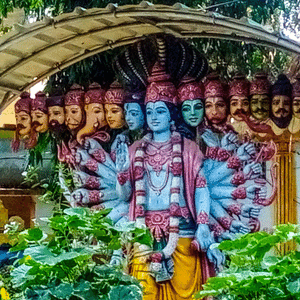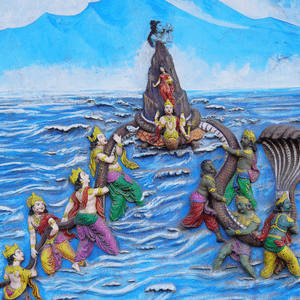मत्स्य अवतार: सृष्टि के नवीनीकरण की अद्भुत गाथा
मत्स्य अवतार, भगवान विष्णु के दस प्रमुख अवतारों में पहला है। इस अवतार में, भगवान विष्णु ने एक मछली का रूप धारण किया था ताकि प्रलय (महाप्रलय) के दौरान ज्ञान की रक्षा कर सकें और मनुष्यता को नई सृष्टि में मार्गदर्शन प्रदान कर सकें। इस अवतार का वर्णन विशेष रूप से भागवत पुराण और मत्स्य पुराण में मिलता है। इस अवतार के माध्यम से धर्म की रक्षा और अधर्म के नाश का विश्वव्यापी संदेश प्रस्तुत किया गया है।
महाराज सत्यव्रत और दिव्य मुलाकात
उस समय पृथ्वी पर धर्मात्मा राजा सत्यव्रत राज्य कर रहे थे, जो भगवान विष्णु के परम भक्त थे, जिन्हें बाद में मनु के रूप में जाना गया। जब वे भगवान विष्णु के मत्स्य अवतार से मिले, तब वह कृतमाला नदी में स्नान कर रहे थे। कृतमाला नदी वर्तमान में दक्षिण भारत में है, और कुछ संदर्भों में इसे वैगै नदी के नाम से भी जाना जाता है। यह घटना इसलिए महत्वपूर्ण है क्योंकि इसके माध्यम से मानवता और सृष्टि के संरक्षण का मार्ग प्रशस्त हुआ।
मत्स्य अवतार (Matsya Avatar) का विकास और प्रलय की भविष्यवाणी
एक दिन सूर्योदय के समय नदी में स्नान करते हुए सत्यव्रत को एक छोटी मछली असाधारण परिस्थिति में मिली। स्नान के पश्चात् राजा सत्यव्रत ने भगवान् सूर्य को अर्पण करने के लिए अपने हाथों में जल उठाया तो उसमें एक छोटी मछली आ गई। महाराज सत्यव्रत ने उस मछली को वापिस जल में छोड़ने का प्रयास किया तो वह मछली उनसे उसके प्राण-रक्षा की प्रार्थना करने लगी। मछली सत्यव्रत से बोली – हे राजन! जल के बड़े जीव इस नदी में रहने वाले छोटे जीवों को मारकर खा जातें हैं इसीलिए कृपा कर आप मेरे प्राणो की रक्षा कीजिये। महाराज सत्यव्रत ने दया और करुणा दिखाते हुए, इस छोटी मछली को अपने कमंडल (एक पवित्र जल पात्र) में रख लिया। उस समय उन्हें यह नहीं पता था कि यह छोटी मछली वास्तव में भगवान विष्णु का मत्स्य अवतार है। इस प्रकार, एक साधारण कार्य – एक छोटी मछली की रक्षा करना – ने महाराज सत्यव्रत को एक दिव्य और महत्वपूर्ण भूमिका में ला दिया।
मतस्यपुराण के अनुसार, कमंडल में रखी गयी यह मछली बहुत तेजी से बड़ी होने लगी, और रातभर में ही उसका शरीर इतना बाद गया की उसका कमंडल में रहना दूभर हो गया । तब मछ्रली ने राजा सत्यव्रत से कहा – हे राजन, कृपा कर मेरे लिए किसी दूसरे स्थान का प्रबंध कीजिये, तब सत्यव्रत ने इसे एक बड़े पानी के घड़े में रख दिया । अगली ही सुबह राजा सत्यव्रत का फिर से एक घोर अचरज से सामना हुआ क्यूंकि रातभर में ही मछली का शरीर इतना बढ़ गया की उसे रखने के लिए घड़ा भी छोटा पड़ गया। सत्यव्रत ने मछली को एक सरोवर में स्थान दिया, और कुछ ही समय में वह भी मछली के लिए छोटा पड़ गया। इसके बाद राजा सत्यव्रत ने मछली को पहले एक नदी और अंत में समुद्र में छोड़ दिया।
राजा सत्यव्रत के आश्चर्य का अंत अभी भी नहीं हुआ था क्यूंकि जल्दी ही विशाल समुद्र भी मछली के रहने के लिए छोटा पड़ने लगा और मछली ने फिर से राजा से प्रार्थना की। मछली ने कहा की हे राजन, अब ये समद्र भी मेरे रहने के लिए उपयुक्त नहीं है और आपने मेरे प्राणो की रक्षा का उत्तरदायित्व लिया हुआ है इसीलिए आप ही मेरे रहने का प्रबंध कहीं और कीजिये। अबतक राजा सत्यव्रत को यह भान हो गया कि यह कोई साधारण मछली नही बल्कि स्वयं भगवान विष्णु ही हैं। तब सत्यव्रत ने हाथ जोड़कर आदर व् विनम्र भाव से पूछा, “हे परमशक्ति, आप कौन हैं, जो मुझे आश्चर्य की गहराइयों में ले गए हैं? कृपया मुझे अपने दर्शन दें”। इस पर भगवान विष्णु ने राजा सत्यव्रत को अपने परमालोकिक मत्स्य अवतार के दर्शन दिए। भगवान् ने राजा सत्यव्रत को बताया, “मैं हयग्रीव नामक राक्षस का संहार करने के लिए मत्स्य अवतार में आया हूँ, जिसने धोखे और अधर्म से वेदों को चुरा लिया है, जिसके कारण संसार में अज्ञानता और अधर्म का प्रसार हुआ है। भगवान विष्णु ने राजा सत्यव्रत को आदेश दिया कि वे सप्त ऋषियों, विभिन्न जीवों के सूक्ष्म रूप और जीवन के लिए अनिवार्य अन्य सामग्री को एक विशाल नौका में सुरक्षित रखें। भगवान ने यह भी निर्देशित किया कि इस नौका को एक विशाल मत्स्य के सींग से बांधा जाना चाहिए, जिसके लिए वासुकि नाग का प्रयोग करना होगा। इस प्रकार, वासुकि नाग की सहायता से, नौका को मत्स्यावतार के सींग से बांधा गया। इसके बाद, मत्स्यावतार ने नौका को प्रलय के जल से पार कराया और सभी की सुरक्षा की। यह घटना हिंदू धर्म में आस्था, भक्ति और दिव्य कृपा का प्रतीक है।
नौका निर्माण और सृष्टि का संरक्षण
राजा सत्यव्रत ने भगवान के आदेशों का पालन किया, और सातवें दिन, जब पृथ्वी पर प्रलय का ज्वार उठा और समुद्रों ने अपनी सीमाओं को लांघ दिया, सब कुछ जलमग्न हो गया, तब निर्देश के अनुसार, सत्यव्रत ने सप्त ऋषियों को नाव में बिठाया, विभिन्न जीवों के सूक्ष्म रूप, महत्वपूर्ण अनाज और औषधियों को संग्रहीत किया, और वे स्वयं भी नाव पर चढ़ गए। समुद्र की उग्रता के कारण नाव स्वतः ही चल पड़ी। चारों ओर केवल जल ही जल दिखाई दे रहा था। इसी बीच, सत्यव्रत ने मत्स्य रूपी भगवान श्री हरि को देखा और उनसे आत्मज्ञान प्राप्त किया, जिससे सत्यव्रत और सप्तऋषि धन्य हो गए। जब प्रकोप शांत हुआ, तब भगवान ने हयग्रीव से वेदों को पुनः प्राप्त किया और उन्हें ब्रह्मा जी को वापस सौंप दिया। इस प्रकार भगवान श्री हरि विष्णु ने मत्स्यावतार धारण करके वेदों का उद्धार किया और जीवों का कल्याण किया।
यह कथा हिन्दू धर्म की पौराणिक कथाओं में एक महत्वपूर्ण प्रसंग है, जो सृष्टि के नवनिर्माण, धर्म की रक्षा, और अधर्म के विनाश के महत्व को दर्शाती है। यह हमें सत्य और न्याय के प्रति अग्रसर होने का संदेश देती है। भगवान श्रीहरि विष्णु सृष्टि के संरक्षण और धर्म की रक्षा के लिए सदैव तत्पर रहते हैं।
धार्मिक ग्रंथों में मत्स्य अवतार
- श्रीमद्भागवत पुराण: भगवान विष्णु के दस अवतारों, उनके जीवन और कृत्यों का वर्णन करता है।
- विष्णु पुराण: भगवान विष्णु के विभिन्न अवतारों और उनकी लीलाओं का वर्णन।
- महाभारत: मत्स्य अवतार से संबंधित कथाएँ।
- पद्म पुराण और ब्रह्मवैवर्त पुराण: मत्स्य अवतार से संबंधित विविध प्रसंगों का वर्णन।
।। जय श्री हरि।।
Matsya Avatar: The Wonderful Saga of Creation’s Renewal
Matsya Avatar, the first of Lord Vishnu’s ten principal incarnations. In this incarnation, Lord Vishnu took the form of a fish to protect knowledge during the deluge (great flood) and to guide humanity in the new creation. This avatar is especially described in the Bhagavata Purana and Matsya Purana. Through this avatar, the universal message of protecting righteousness and destroying unrighteousness is presented.
King Satyavrata and the Divine Encounter
At that time, the righteous King Satyavrata, who later became known as Manu, was ruling on Earth and was a devout follower of Lord Vishnu. He met Lord Vishnu’s Matsya Avatar while he was bathing in the Kritamala River, which is now in South India, and is also known in some references as the Vaigai River. This event is significant because it paved the way for the preservation of humanity and creation.
Matsya Avatar: Evolution and Prophecy of the Deluge
One day at sunrise, while bathing in the river, Satyavrata found a small fish under extraordinary circumstances. After bathing, when King Satyavrata scooped water in his hands to offer to the Sun God, a small fish came into it. King Satyavrata tried to release the fish back into the water, but the fish begged him to save its life. The fish spoke to Satyavrata, saying, “O King! Large creatures in this river eat the smaller ones; therefore, please protect my life.” Moved by compassion, King Satyavrata kept the small fish in his water pot (Kamandalu), not knowing it was actually Lord Vishnu’s Matsya Avatar. Thus, a simple act of saving a small fish brought King Satyavrata into a divine and significant role.
According to the Matsya Purana, the fish in the kamandalu grew rapidly, and overnight it became so large that it could no longer fit in the pot. The fish then asked King Satyavrata to arrange another place for it, so he placed it in a large water jar. The next morning, King Satyavrata was again astonished because overnight, the fish had grown so large that the jar became too small. Satyavrata then placed the fish in a lake, and in no time, it became too small for the fish. Subsequently, King Satyavrata released the fish first into a river and finally into the ocean.
King Satyavrata’s astonishment had not ended yet, as soon the vast ocean also became too small for the fish, and it again prayed to the king. The fish said, “O King, now even this ocean is not suitable for me, and you have taken the responsibility to protect my life, so please arrange another place for me to stay.” By now, King Satyavrata realized that this was no ordinary fish but Lord Vishnu himself. Then, with folded hands and a respectful demeanor, Satyavrata asked, “O Supreme Power, who are you who have taken me to the depths of wonder? Please reveal yourself to me.” Lord Vishnu then granted King Satyavrata a vision of His divine Matsya form. The Lord told King Satyavrata that He had come in the form of Matsya to destroy the demon Hayagriva, who had stolen the Vedas through deceit and unrighteousness, causing the spread of ignorance and unrighteousness in the world. Lord Vishnu commanded King Satyavrata to safely keep the saptrishis, various microforms of life, and other essentials for life on a huge boat. The Lord also directed that this boat should be tied to the horn of a vast fish using the serpent Vasuki. Thus, with the help of Vasuki, the boat was tied to the horn of the Matsya Avatar. Afterwards, the Matsya Avatar navigated the boat through the deluge waters and ensured everyone’s safety. This event is a symbol of faith, devotion, and divine grace in Hinduism.
Construction of the Boat and Preservation of Creation
King Satyavrata followed the Lord’s commands, and on the seventh day, when a tide of destruction rose on Earth and the seas crossed their boundaries, submerging everything, as instructed, Satyavrata boarded the boat with the saptrishis, various microforms of life, essential grains, and medicines, and set sail himself. Due to the ferocity of the sea, the boat began moving on its own. Water was visible everywhere. Meanwhile, Satyavrata saw Lord Sri Hari in the form of Matsya and received self-knowledge, blessing himself and the saptrishis. When the calamity subsided, the Lord recovered the Vedas from Hayagriva and returned them to Lord Brahma. Thus, Lord Sri Hari Vishnu, in the form of Matsya, rescued the Vedas and benefitted all beings.
This story is an important episode in the mythological stories of Hinduism, highlighting the importance of re-creation, protection of righteousness, and destruction of unrighteousness. It sends a message to advance towards truth and justice. Lord Sri Hari Vishnu is always ready to protect creation and uphold righteousness.
Matsya Avatar in Religious Texts
- Shrimad Bhagavata Purana: Describes the ten avatars of Lord Vishnu, their lives, and deeds.
- Vishnu Purana: Describes the various avatars of Lord Vishnu and their divine play.
- Mahabharata: Stories related to Matsya Avatar.
- Padma Purana and Brahmavaivarta Purana: Descriptions of various episodes related to Matsya Avatar.
|| Jai Shri Hari ||

